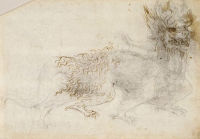The Natural World Click on the thumbnails to explore the trail
Read more about this trail (expand)
Leonardo’s endless curiosity regarding the form and function of all natural phenomena is attested to in his drawings, manuscripts and paintings. As nature could only be understood by direct “experience” or engagement with real life models, man, plants, animals, and the world that they inhabited became the subject of intense scrutiny in the quest for understanding of all natural things.

- Enlarge
- Zoom & explore
- The Royal Collection © 2005, Her Majesty Queen Elizabeth II
Study of a dragon c1512-13
Leonardo’s knowledge of animals provided the basis for the creation of imaginary creatures and fantastical monsters.
According to legend, Leonardo’s father was approached by a peasant who had made a wooden shield and wanted to have it painted. Ser Piero gave the shield to Leonardo who painted on it “a great ugly creature…producing the same effect as the head of Medusa”. According to the story, Leonardo put together bits of lizards, serpents, butterflies, bats and other animals. He painted the beast as coming out of a dark rock, belching venom from its throat, fire from its eyes and smoke from its nostrils. On receiving the completed shield from Leonardo, his father, rather than returning it to the peasant, sold it to the Duke of Milan for 300 ducats!
In this drawing, Leonardo creates an imaginary monster. The proportions and shape of the body and head suggest that this is a design for a costume to house two performers, much like a pantomime horse. The designing of costumes and props for festivities and theatrical productions was a major interest of Leonardo’s of which little evidence survives today.
In Leonardo's words
You know that it is impossible to fashion any animal without its individual parts, and that each of these in itself will bear a resemblance to those of other animals. Therefore if you wish to make your imaginary animal seem natural, let us say it was a serpent, take for the head that of a mastiff or a hound, the eyes of a cat, the ears of a porcupine, the nose of a greyhound, the brow of a lion, the temples of an old cock, and the neck of a turtle.
In this drawing, Leonardo creates an imaginary monster reminiscent of a Chinese dragon. The proportions and manner in which the body and head of the dragon are articulated in this drawing seems to suggest that this is a design for a costume to house two performers, in the manner of a pantomime horse.
The designing of costumes and props for festivities, masquerades and theatrical productions was an enduring interest of Leonardo’s, of which little evidence survives today.
- Medium Pen and ink over black chalk or charcoal
- Size 18.8 x 27 cm
- Location The Royal Collection










